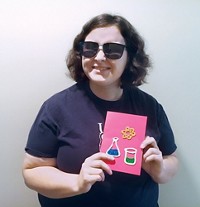Advertisement
Grab your lab coat. Let's get started
Welcome!
Welcome!
Create an account below to get 6 C&EN articles per month, receive newsletters and more - all free.
It seems this is your first time logging in online. Please enter the following information to continue.
As an ACS member you automatically get access to this site. All we need is few more details to create your reading experience.
Not you? Sign in with a different account.
Not you? Sign in with a different account.
ERROR 1
ERROR 1
ERROR 2
ERROR 2
ERROR 2
ERROR 2
ERROR 2
Password and Confirm password must match.
If you have an ACS member number, please enter it here so we can link this account to your membership. (optional)
ERROR 2
ACS values your privacy. By submitting your information, you are gaining access to C&EN and subscribing to our weekly newsletter. We use the information you provide to make your reading experience better, and we will never sell your data to third party members.
Education
High School Science
C&EN examines the impact of dedicated teachers and volunteers, as well as revisions to AP chemistry
by Sophie L. Rovner
September 12, 2011
| A version of this story appeared in
Volume 89, Issue 37

Do you remember what sparked your love for chemistry?
COVER STORY
High School Science
Perhaps your enthusiasm originated in elementary school, when a visiting scientist presented an exhilarating demonstration. Or maybe a high school chemistry teacher noticed your facility with the subject and took a special interest in developing your talent.
Chemists of the future are likely to look back fondly on one such educator: Michelle M. Shearer, a chemistry teacher at Urbana High School, in Ijamsville, Md., who is the 2011 National Teacher of the Year (C&EN, May 16, page 3).
Shearer credits her relationship with her students for much of her success. “My recognition of the power of human connection seems to have the most profound effect on my students’ achievement, especially those who doubt their ability to succeed in challenging college-level science, technology, engineering, and mathematics (STEM) courses,” Shearer said when the Council of Chief State School Officers announced her selection.
That same commitment to personal interaction with students distinguishes the four high school science teachers whom Senior Editor Linda Wang profiles in the first article in C&EN’s Back to School feature package. These dedicated teachers work magic in the classroom despite having few resources at hand.
Next, Senior Editor Susan J. Ainsworth chronicles the experiences of volunteer coaches who visit local schools to lend support to teachers as they introduce their students to chemistry.
In the final story of the series, Associate Editor Jyllian Kemsley examines efforts to revise the Advanced Placement chemistry curriculum and exam to enhance students’ grasp of the material.
We hope these stories will provide inspiration as you work to overcome challenges associated with chemistry education in your own school district.




Join the conversation
Contact the reporter
Submit a Letter to the Editor for publication
Engage with us on Twitter